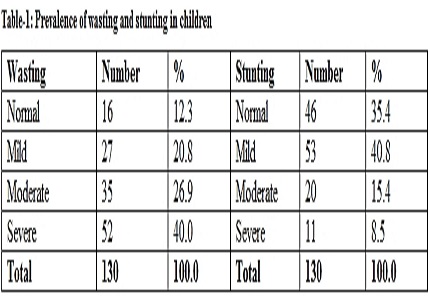A clinical study of nutritional status under 5 years of age in correlation with iron deficiency Anemia
Abstract
Introduction: Malnutrition is by far the biggest contributor to child mortality, present in half of all the cases globally. Malnutrition is more common in India than in Sub-Saharan Africa. One in every three malnourished children in the world lives in India. The nutritional status of an individual is often the result of many interrelated factors.
Objectives: To identify the nutritional status under 1-5 years of age. To assess the prevalence of iron deficiency anemia in children under 1-5 years of age.
Method: The present study is a cross-sectional study conducted in Vydehi Institute of Medical Sciences and Research Centre and Hospital in Bangalore. During the study period about 130 children were enrolled who fulfils the inclusion criteria and those who admitted in Paediatric ward. This study was taken up with the purpose of assessment of nutritional status and the relationship of nutritional status with iron deficiency anemia in children under 5 years of age.
Results: According to IAP grading of malnutrition, 12.4% and 28.5% children were belonged to grade IV and III, 36.9% and 22.3% of children belonged to grade I and II malnutrition. According to this study, malnutrition was more prevalent in female children. The prevalence of severe and moderate, wasting was 40% and 26.9%, stunting 8.5% and 15.4%, MUAC 11.5% and 25.4%. Prevalence of severe and moderate thinness of children according to body mass index was 46.9% and 36.9% respectively. The prevalence of iron deficiency anemia in malnourished children was 48.5% and it was also found that 11.5% of children were severely anemic and 30.8% of children were moderately anemic.
Conclusion: Malnutrition is a significant problem under 5 years of age which can be reduced with proper education, growth monitoring and good nutrition.
Downloads
References
2. Hassam. SL, Mahmood UR, et al. Assessment of nutritional status of 1-5 year old children in an urban council of Abbottabad. J. Ayub Med Coll Abbottabad 2010;22(3):124-127.
3. Singh R, Bhatnagar M, Mathur B, Singh H, & Kr Y. Comparative study of nutritional status of primary school children in urban area of Jhansi. Indian J Commun Health 2009-2010; 21(1,2):56-60.
4. Arlappa N, Balakrishna N, Laxmaiah A, Brahmam GNV. Prevalence of anemia among rural preschool children of Maharashtra, India. Indian J Commun Health 2012;24(1):4-8.
5. Park K. Park’s Text book of Preventive and Social Medicine. 21st ed. Jabalpur: M/s. Banarsidas Bhanot Publishers; 2011.
6. Tetzel B. S. Oxford Text book of Public Health . Oxford.Oxford University Press; 1985.
7. Joshi HS, Joshi MC, Arun Singh et al. Determinants of Protein Energy Malnutrition (PEM) in 0-6 Years Children in Rural Community of Bareilly. Indian J Prev. Soc. Med. 2011;42(2):154-158.
8. Imran M, Nawazudin K et al., A Study on Prevalence and Determinants of Protein Energy Malnutrition among 2-6 Year Anganwadi children in rural Bangalore. International Journal of Basic and Applied Medical Sciences.2012;2(3):109-115.
9. Tripathi MS, Sharma V. Assessment of nutritional status of pre-schoolers in Slum areas of Udaipur city. Indian J Community MedPublic Health. 2015 May;2(2):124-126.
10. Harishankar, Dwivedi S, Darbal SB, Walia DK. Nutritional status of children under 6 years of age. Indian J Prev. Soc. Med .2004; 35(3&4):156-62.
11. Jood S, Bishnoi S, Sehgal S, Nutritional status of rural pre-school children of Haryana State. Indian J Pediatr 2000;67(3):189-196.
12. Sudhagandhi B, Prema A et al., Anemia in Toddlers Of Kattankulathur, Kancheepuram District (TN), India. Indian J Pharma 2012;3:687-691.
13. Alzain Bassam.. Anemia and Nutritional Status of Preschool Children in North Gaza, Palestine. International Journal of Scientific & Technology Research .2012 Dec;1(11):86-91.
14. Singh BM, Lakshminarayana J et al. Childhood Illnesses and Malnutrition in under Five Children in Drought Area of Western Rajasthan. India. J Commun Dis. 2006;38(1):88-96.
15. Vinod N, Umesh S et al. Morbidity Profile in under Five Children in Urban Slum Area of Nagpur. National J Commun Med 2012 Jul-Sept;3(3):442-446.
16. George KA, Suresh Kumar N, John J Lal, Sreedevi R. Anemia and nutritional status of pre-school children in Kerala. Indian J Pediatr 2000 Aug; 67(8): 575-78.
17. Awasthi S, Das R, Verma T, Vir S. Anemia and undernutrition among preschool children in Uttar Pradesh, India. Indian Pediatr. 2003 Oct;40(10):985-90.
18. Bains K, Brar JK. Assessment of nutritional status of 1-5 year old children belonging to farm families of Punjab, Indian J Nutr Diet 2009;46:345-50.
19. Muaz SSA, Hasan MR, Shamim SA. Nutritional status of 1-5 years children of the tea workers in Sylhet division. Bangladesh J Child Health 2010; Vol 34 (1): 11-16.
20. Biswas S, Bose K, Mukhopadhyay A, Bhadra M. Prevalence of undernutrition among pre-school children of Chapra, Nadia District, West Bengal, India, measured by composite index of anthropometric failure (CIAF). Anthropol Anz. 2009 Sep;67(3):269-79.
21. Luthra M, Paevan UC. Epidemiological correlates of under nutrition in o-5 year old children in rural field areas of SGRRIM & HS, Dehradun. Indian J Prev. Soc. Med. 2010; 41 (1 & 2):8-10.

Copyright (c) 2017 Author (s). Published by Siddharth Health Research and Social Welfare Society

This work is licensed under a Creative Commons Attribution 4.0 International License.


 OAI - Open Archives Initiative
OAI - Open Archives Initiative


